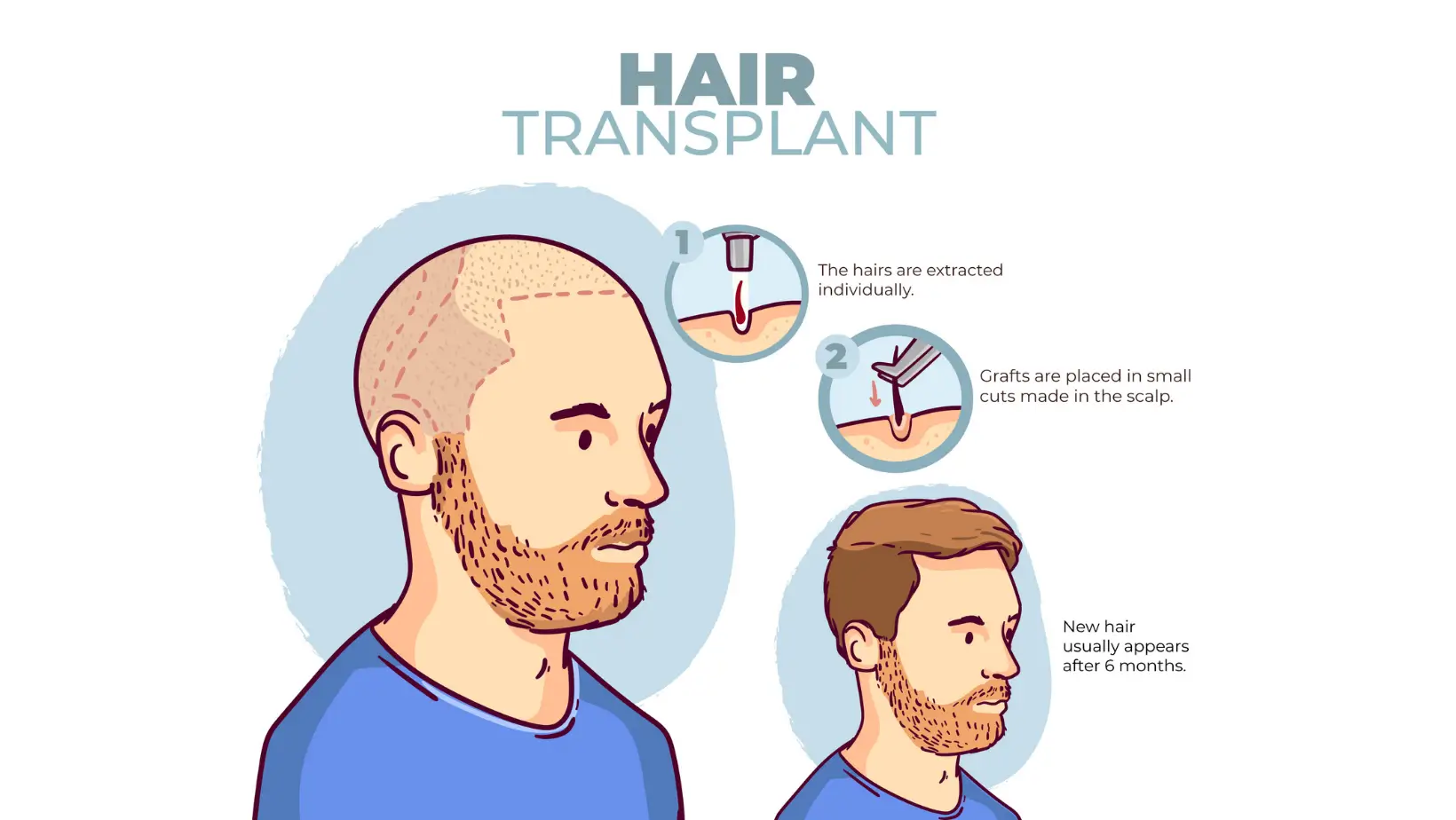Understanding the hair transplant timeline is crucial for patients considering this transformative procedure. Research indicates that a well-defined recovery journey helps manage expectations and ensures optimal results. The hair transplant timeline typically spans from the initial consultation through the final results, with several distinct phases that patients experience. Scientific studies show that while individual healing rates may vary, the biological processes following transplantation follow a predictable pattern, allowing medical professionals to provide accurate guidance about what to expect at each stage.
Table of Contents
The comprehensive hair transplant timeline encompasses both immediate post-operative changes and long-term growth patterns. Clinical data demonstrates that the first 48 hours involve minimal recovery, followed by a scabbing phase lasting approximately 7-10 days. Patients typically experience shedding between weeks 2-8, a natural occurrence known as “shock loss” that affects up to 95% of transplanted follicles. The regrowth phase begins around month 3-4, with significant improvements visible between months 6-9. Medical documentation confirms that final results typically manifest between 12-18 months post-procedure, when transplanted follicles establish their permanent growth cycle and achieve natural density. This established timeline provides patients with a reliable roadmap throughout their hair restoration journey.
Hair Transplant Growth Process and Expected Results
Understanding the hair transplant growth timeline helps patients set realistic expectations. The journey from procedure to final results follows a predictable pattern with distinct phases that vary slightly depending on individual factors and treatment areas.
Immediate Post-Transplant Phase
- Days 1-5: Transplanted grafts are visible as small crusts in the recipient area
- Days 5-10: Initial scabbing begins to fall off naturally
- Days 10-14: Most visible signs of the procedure diminish as healing progresses
- Days 14-21: The “shock loss” phase often begins where transplanted hairs shed temporarily
Early Growth Stage
- Weeks 3-4: Complete shedding of transplanted hair commonly occurs
- Weeks 4-8: The recipient area may appear similar to pre-procedure condition
- Month 2: Tiny hair growth may begin to appear in some patients
- Month 3: Initial hair growth becomes visible in most patients, albeit thin and uneven
- Month 4: Crown transplant timeline typically shows first visible improvements
Mid-Term Growth Progress
- Month 5: Hair growth becomes more noticeable with improved density
- Month 6: Approximately 60-70% of the final hair transplant results become visible
- Month 7-8: Hair thickness and growth rate increase significantly
- Month 9: The FUE growth timeline shows substantial progress in most patients
- Month 10: Hair transplant density timeline demonstrates continued improvement
Final Results and Maturation
- Month 12: Hair transplant final results are generally 90-95% complete
- Month 12-15: Full density and maturation of the hair follicles typically achieved
- Month 15-18: Hair exhibits normal growth cycles and natural appearance
- Year 1 and beyond: Full results of the hair regrowth timeline are established
- Post-year 1: The crown hair transplant growth timeline may continue improving subtly
At CK Health Turkey, we ensure your hair transplant procedure follows this expected timeline under optimal conditions. Our comprehensive approach helps patients achieve the best possible hair transplant growth process with natural-looking results. For more information about the FUE results timeline or to discuss your specific hair transplant timeline, please contact our team of specialists. By adhering to our Hair Transplant Care Guidelines, you can maximize your procedure’s success and minimize recovery time. Our experts are dedicated to providing personalized support and answering any questions you may have throughout your journey.
Post Hair Transplant Recovery and Healing Stages
The fue healing timeline involves several distinct phases that patients must navigate. Understanding the hair transplant timeline day by day helps set realistic expectations and ensures proper care during recovery.
Immediate Post-Operative Recovery
- Days 1-3: Swelling and redness are common in the recipient and donor areas. The fue post op timeline begins with mild discomfort that typically subsides with prescribed pain medication.
- Days 4-7: Scabbing forms around transplanted follicles during the first week after hair transplant. The scalp begins its initial healing process with noticeable redness.
- Days 7-10: Most scabs naturally fall off. At 7 days after hair transplant, patients can usually resume gentle hair washing following surgeon instructions.
- Days 10-14: Redness continues to diminish as the fue redness timeline progresses. The donor area shows significant healing with minimal visible signs of the procedure.
- Days 14-30: External wounds have mostly healed. The fue recovery timeline shows marked improvement in overall scalp appearance with reduced inflammation.
Shock Loss and Shedding Phase
- Weeks 2-4: The hair transplant shedding phase begins as transplanted hairs enter a dormant state. This is a normal part of the fue hair transplant recovery timeline.
- Weeks 4-6: Hair transplant shedding timeline continues with most transplanted hairs shed. This temporary phase is essential for new growth.
- Weeks 6-8: At 2 months after hair transplant, the shedding phase generally concludes. The scalp may appear similar to pre-procedure state.
- Weeks 8-12: Hair transplant shock loss timeline reaches completion. The follicles remain dormant but are preparing for new growth.
- Weeks 12-16: Hair transplant after 4 months shows the beginning of new growth emerging from transplanted follicles.
Healing and Regrowth Milestones
- Months 3-4: Initial growth begins as fine, thin hairs emerge. The fue hair transplant regrowth timeline shows the first visible signs of success.
- Months 4-6: New growth becomes more noticeable with increasing thickness. The hair transplant healing stages progress as expected.
- Months 6-8: Transplanted hair continues thickening and may require first styling. Hair transplant week by week progress becomes more evident.
- Months 8-10: The hair restoration timeline shows significant improvement with increased density and natural appearance.
- Months 10-12: The fue progress timeline approaches completion with nearly full results visible. Hair transplant healing timeline nears its final stage.
FUT Hair Transplant Timeline
The FUT hair transplant timeline follows a structured progression that ensures optimal results for patients seeking permanent hair restoration. Understanding each phase of this journey helps set realistic expectations and prepare properly.
- Consultation Day (Day 0): Medical evaluation, determining candidacy, and creating a customized treatment plan based on hair loss pattern and donor area availability.
- Surgery Day (Day 1): The procedure typically takes 4-8 hours depending on the number of grafts. The surgeon removes a strip from the donor area, technicians dissect it into individual follicular units, and these are implanted into recipient areas.
- Initial Recovery (Days 2-7): Patients experience mild discomfort and swelling around the donor area. The linear FUT scar remains tender, and special care instructions must be followed. Sleeping in an elevated position helps reduce swelling during this critical phase of the fut recovery timeline.
- Suture Removal (Days 10-14): Stitches from the donor area are removed, marking an important milestone in the fut transplant timeline. The linear scar begins its healing process.
- Return to Normal Activities (Days 14-21): Most patients can resume regular activities including mild exercise. The donor area scar continues to heal and flatten.
- Shedding Phase (Weeks 2-8): Temporary shedding of transplanted hairs occurs—a normal part of the fut hair transplant recovery timeline that should not cause concern.
- Healing Completion (Months 3-4): The donor area scar matures and typically flattens. Patients can now cut their hair shorter if desired.
- Long-term Recovery (Months 6-12): The complete fut timeline concludes as transplanted follicles establish and strengthen. The donor scar continues to fade.
DHI Hair Transplant Recovery Timeline
The DHI hair transplant recovery timeline follows a specific pattern that helps patients understand what to expect during their healing journey. This advanced technique offers distinct advantages in terms of recovery compared to other methods.
- Immediate Post-Operation (Day 1-3)
- Mild swelling and redness around the recipient area
- Minimal discomfort that can be managed with prescribed medications
- Small scabs forming around the implanted follicles
- No bandages required due to the minimally invasive nature of DHI
- Early Recovery Phase (Day 4-10)
- Reduction in initial swelling and redness
- Washing of hair permitted using special techniques and products
- Crusts begin to naturally fall off
- Temporary shock loss may begin (normal part of the DHI recovery timeline)
- Intermediate Recovery (Day 11-30)
- Complete resolution of visible scabbing
- Return to most normal daily activities
- Continued adherence to avoiding direct sunlight on transplanted area
- Sleeping position restrictions can typically be relaxed
- Advanced Recovery (Month 2-3)
- Initial new hair growth may become visible
- Donor area completely healed with no visible signs of extraction
- DHI recovery timeline shows faster healing than traditional methods
- Return to full exercise regimen permitted
- Final Healing Stage (Month 4-6)
- Continued strengthening of transplanted hair
- Natural hair growth cycle fully established
- Complete integration of transplanted follicles
- Final assessment of density and distribution pattern
Our specialized protocols ensure the smoothest dhi hair transplant recovery timeline possible, with consistent monitoring throughout each phase. Our medical team offers personalized guidance throughout your recovery journey, ensuring that every patient achieves the best possible results. For more information about the DHI recovery timeline or to schedule a consultation, please contact our dedicated patient coordinators.
Specialized Hair Transplant Timelines
- Female hair transplant timeline differs slightly from male procedures, with most women seeing initial growth at 3-4 months. Complete results typically manifest between 12-15 months, with special consideration for female pattern hair loss characteristics requiring customized treatment approaches.
- Turkey hair transplant timeline follows international standards but often includes comprehensive packages with 3-day in-country stays. Day 1 involves the procedure, while days 2-3 include initial washing and aftercare education before international patients return home, with follow-up conducted remotely.
- Bosley hair transplant timeline typically spans 12-18 months for complete results. Their protocol includes proprietary aftercare products applied at specific intervals: immediately post-surgery, 2 weeks, 1 month, 3 months, and 6 months to enhance transplant success rates.
- Hairline transplant timeline focuses specifically on frontal restoration, with visible improvements beginning at 4-6 months. The critical design phase requires extra consultation time before surgery to ensure natural-looking results that complement facial features and future aging patterns.
- The timeline for a 2nd hair transplant requires waiting at least 12 months after the initial procedure. This waiting period ensures complete healing and allows surgeons to accurately assess density needs for the follow-up procedure, leading to more predictable outcomes.
- Neograft recovery timeline features quicker healing due to its minimally invasive nature. Patients typically return to work within 3-5 days, experience reduced visible scarring within 7-10 days, and see complete extraction site healing within 14 days.
- Hair implant timeline from consultation to final results spans approximately 12-18 months. The procedure itself takes between 4-8 hours depending on graft count, with most clinics allocating a full day for the transplantation process.
- How long does hair transplant take as a procedure? Most sessions require 4-8 hours of surgical time depending on the number of grafts being transplanted, with mega-sessions of 3000+ grafts potentially requiring up to 10 hours.
Understanding the realistic timeline for hair transplant outcomes helps manage expectations. While initial growth begins at 3-4 months, the complete transformation typically requires 12-15 months as transplanted follicles synchronize with your natural hair growth cycle.
For more information about our specialized hair transplant procedures or to discuss your personal timeline expectations, please contact our expert team directly.



